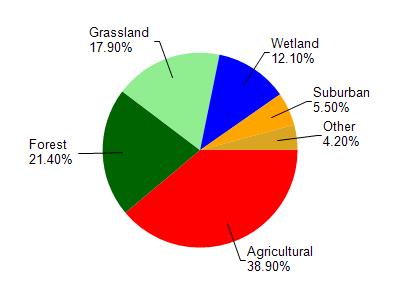Sheboygan
No
No
No
Fish and Aquatic Life
Overview
Otter Pond is a spring pond at the site of an old gravel pit; there is a small flow entering from Glenbeulah Springs and a stable flow leaving the pond at the dam to the Mullet River. The shoreline is bog marsh, with points of rock and gravel at various places around the pond. The bottom consists primarily of marl, with a dense growth of water milfoil in shallow areas and a heavy growth of watercress near the springs. There is no development of the shoreline, except the shell of an old log cabin near the dam. Beaver Dam on the Mullet River has flooded the entire area--raising Otter Pond about two feet. The present fishery consists of largemouth bass, crappies and sunfish and northern pike. The quality and clarity of this water in the area suggest much potential for trout management. The area has considerable wildlife value. A mixture of marsh, uplands and forests provides habitat for ducks, squirrels, pheasant, deer and ruffed grouse. The pond is within the Kettle Moraine State Forest.
Source: 1968, Surface Water Resources of Sheboygan County Otter Pond T15N, R21E, Section 6 (8) Surface Acres = 2.7, S.D.F. = 1.17, Maximum Depth = 10 feet
Date 1968
Author Aquatic Biologist
Condition
Wisconsin has over 84,000 miles of streams, 15,000 lakes and milllions of acres of wetlands. Assessing the condition of this vast amount of water is challenging. The state's water monitoring program uses a media-based, cross-program approach to analyze water condition. An updated monitoring strategy (2015-2020) is now available. Compliance with Clean Water Act fishable, swimmable standards are located in the Executive Summary of Water Condition in 2018. See also the 'monitoring and projects' tab.
Management Goals
Wisconsin's Water Quality Standards provide qualitative and quantitative goals for waters that are protective of Fishable, Swimmable conditions [Learn more]. Waters that do not meet water quality standards are considered impaired and restoration actions are planned and carried out until the water is once again fishable and swimmable
Management goals can include creation or implementation of a Total Maximum Daily Load analysis, a Nine Key Element Plan, or other restoration work, education and outreach and more. If specific recommendations exist for this water, they will be displayed below online.
Monitoring
Monitoring the condition of a river, stream, or lake includes gathering physical, chemical, biological, and habitat data. Comprehensive studies often gather all these parameters in great detail, while lighter assessment events will involve sampling physical, chemical and biological data such as macroinvertebrates. Aquatic macroinvertebrates and fish communities integrate watershed or catchment condition, providing great insight into overall ecosystem health. Chemical and habitat parameters tell researchers more about human induced problems including contaminated runoff, point source dischargers, or habitat issues that foster or limit the potential of aquatic communities to thrive in a given area. Wisconsin's Water Monitoring Strategy was recenty updated.
Grants and Management Projects
| Project Name (Click for Details) | Year Started |
|---|
|
|
Monitoring Projects
| WBIC | Official Waterbody Name | Station ID | Station Name | Earliest Fieldwork Date | Latest Fieldwork Date | View Station | View Data |
|---|
| 55300 | Otter Pond | 10005805 | Otter Pond | 7/27/1999 | 7/9/2001 | Map | Data |
|

Watershed Characteristics
Otter Pond is located in the Mullet River watershed which is 88.19 mi². Land use in the watershed is primarily agricultural (38.90%), forest (21.40%) and a mix of grassland (17.90%) and other uses (21.80%). This watershed has 97.54 stream miles, 789.87 lake acres and 6,609.38 wetland acres.
Nonpoint Source Characteristics
This watershed is ranked High for runoff impacts on streams, Not Ranked for runoff impacts on lakes and High for runoff impacts on groundwater and therefore has an overall rank of High. This value can be used in ranking the watershed or individual waterbodies for grant funding under state and county programs.However, all waters are affected by diffuse pollutant sources regardless of initial water quality. Applications for specific runoff projects under state or county grant programs may be pursued. For more information, go to surface water program grants.